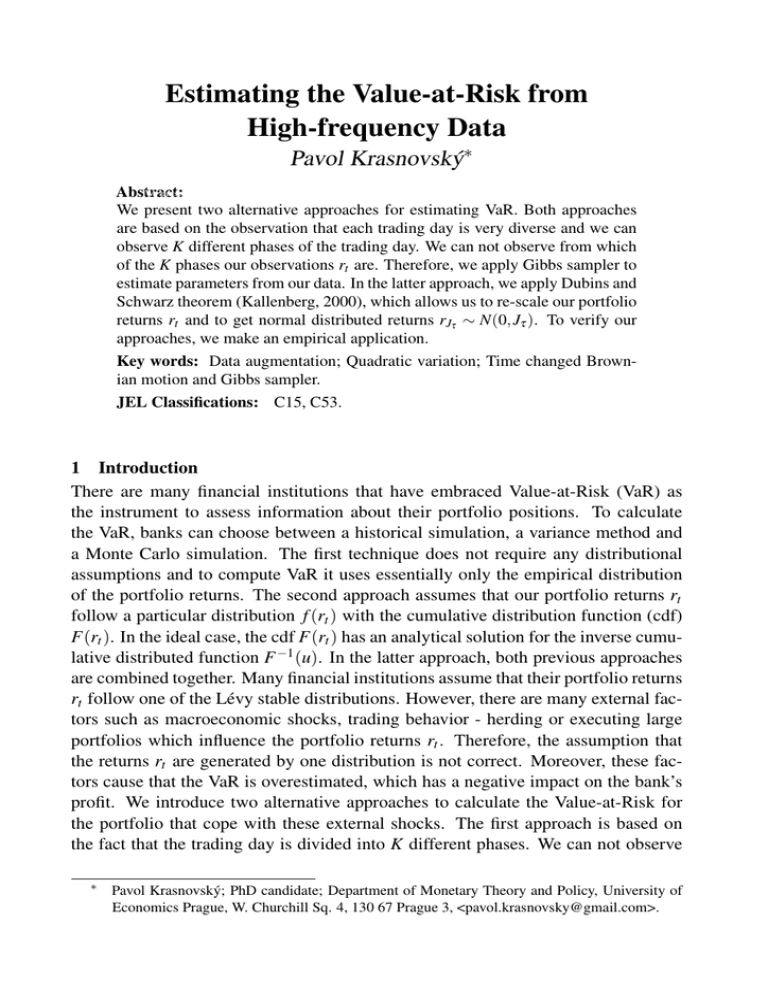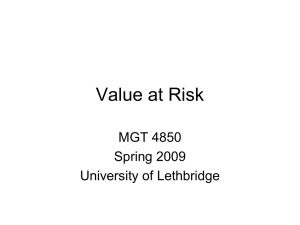full text
advertisement

Estimating the Value-at-Risk from
High-frequency Data
Pavol Krasnovský∗
We present two alternative approaches for estimating VaR.we presentwe presentwe presensdsdsdsdsddsd sd ds dsdsd dsd
aaAbstract:
We present two alternative approaches for estimating VaR. Both approaches
are based on the observation that each trading day is very diverse and we can
observe K different phases of the trading day. We can not observe from which
of the K phases our observations rt are. Therefore, we apply Gibbs sampler to
estimate parameters from our data. In the latter approach, we apply Dubins and
Schwarz theorem (Kallenberg, 2000), which allows us to re-scale our portfolio
returns rt and to get normal distributed returns rJτ ∼ N(0, Jτ ). To verify our
approaches, we make an empirical application.
Key words:trData augmentation; Quadratic variation; Time changed Brownian motion and Gibbs sampler.
JEL Classifications: trC15, C53.
1 Introduction
There are many financial institutions that have embraced Value-at-Risk (VaR) as
the instrument to assess information about their portfolio positions. To calculate
the VaR, banks can choose between a historical simulation, a variance method and
a Monte Carlo simulation. The first technique does not require any distributional
assumptions and to compute VaR it uses essentially only the empirical distribution
of the portfolio returns. The second approach assumes that our portfolio returns rt
follow a particular distribution f (rt ) with the cumulative distribution function (cdf)
F(rt ). In the ideal case, the cdf F(rt ) has an analytical solution for the inverse cumulative distributed function F −1 (u). In the latter approach, both previous approaches
are combined together. Many financial institutions assume that their portfolio returns
rt follow one of the Lévy stable distributions. However, there are many external factors such as macroeconomic shocks, trading behavior - herding or executing large
portfolios which influence the portfolio returns rt . Therefore, the assumption that
the returns rt are generated by one distribution is not correct. Moreover, these factors cause that the VaR is overestimated, which has a negative impact on the bank’s
profit. We introduce two alternative approaches to calculate the Value-at-Risk for
the portfolio that cope with these external shocks. The first approach is based on
the fact that the trading day is divided into K different phases. We can not observe
∗ tr Pavol Krasnovský; PhD candidate; Department of Monetary Theory and Policy, University of
trrerer Economics Prague, W. Churchill Sq. 4, 130 67 Prague 3, <pavol.krasnovsky@gmail.com>.
Krasnovský P.: Estimating the Value-at-Risk from High-frequency Data.
from which K phases our observations rt are. Therefore, we apply Gibbs sampler
to estimate parameters from our data. In the second approach, we apply Dubins and
Schwarz theorem (Kallenberg, 2000), which allows us to re-scale our portfolio returns rt and to get the normal distributed returns rJτ ∼ N(0, Jτ ).
The paper is organized as follows. In Section 2.1, we present well-known variance
method Student-t Distribution, which we use it as our benchmark for our proposal
techniques. In the Section 2.2, we present the Gibbs sampler algorithm for sampling
from the mixture of Gaussian distributions. Since one of the main properties of the
high-frequency returns is the heavy-tailed distribution, Section 2.3 is concerned with
the formulation of the time change techniques represent by the Dubins and Schwarz
theorem (Kallenberg, 2000), and we will use it in the mixture of Gaussian model.
After formulating the methods for computing Value-at-Risk in Section’2.3, we apply
these techniques to the market data and compare the results in Section 3.
2 Methods for Computing Value-at-Risk
In this Section 2, we present three different methods for computing VaR. First approach is a standard variance method for computing VaR. The second approach assume that the portfolio returns rt follow one of the K differ distributions. The latter
technique also allow us to cope with the many properties of high frequency data.
2.1 Student-t Distribution
Many financial institutions use variance technique as the standard approach to estimate VaR of the portfolio. We use this method as a benchmark for two approaches
presented in the Sections 2.2 and 2.3. Now, we assume that the portfolio returns rt
follow a t-distribution, when the log likelihood function equals
(ν ) 1
]
[
(ν +1)
− log Γ
− log πν − log σ −
L =T log Γ
2(
2 )2
( r − µ )2
ν +1 T
t
∑ log 1 + σ √(ν )
2 t=1
(1)
where Γ(·) is the Gamma function, µ ∈ R, σ > 0 is the variance and ν > 0 is the
number of degrees of freedom. The Value-at-Risk can be expressed as follows:
(
)
−1
VaR = −W0 eµ +γ Fν (p) − 1 ,
(2)
where W0 is the initial value of the portfolio and Fν−1 (p) is the cumulative distribution
function of standardized t-distributed random variable.
2.2 Mixture of Gaussians
More suitable approach, which better captures variability of the portfolio, is based
on the idea that the i-th return is from different k distribution. To estimate VaR
6
European Financial and Accounting Journal, 2015, vol. 10, no. 2, pp. 5-11.
from these data, we use Gibbs sampler which can sample from the full conditionals
distributions. We consider portfolio returns r1 , . . . , rn defined by the equation (13)
stem for one of K population N(µk , τ1k ), where k = 1, . . . , K. The mixture distribution
for i−th observation is:
K
f (yi ) =
∑ πk ϕ(µ ,
1
k τ
k
k=1
) (yi ).
(3)
where P(Ri = k) = πk . In a Bayesian analysis a suitable prior distributions for the
unknown parameters µk , τk and πk are
1
)
τ0
τk ∼Γ(α , β )
µk ∼N(µ0 ,
(4)
K
π1 , . . . , πK ∼ f(α1 ,...,αK ) (π1 , . . . , πK ) ∝ ∏ πkαk −1 ,
k=1
π ≥ 0,
K
∑ πk = 1.
k=1
For the simplicity, we will assume that the number of populations K is known. In
the case, where the number of components is variable, the reversible jump algorithm
can be used. To write out the posterior distributions for the unknown variables µk ,
τk and πk given data R1 , . . . , Rn , we suggest auxiliary variables Z1 , . . . , Zn :
P(Zi = k) = πk
Ri |Zi = k ∼ N(µk , 1/τk ).
and
(5)
Thus the posterior distribution is
f (r1 , . . . , rn , z1 , . . . , zn , µ1 , . . . , µK , τ1 , . . . , τK , π1 , . . . , πK ) ∝
( −τ (r − µ )2 ))( K
( −τ (µ − µ )2 ))
( n
zi i
zi
0 k
0
π
exp
exp
∏ zi
∏
2
2
i=1
k=1
)( K
( K
)
αk −1
α −1
τ
β
τ
π
)
exp(−
k
∏ k .
∏ k
(6)
k
k=1
Now, we can simply derive full conditional distributions given R1 , . . . , Rn
(
)
∑ni=1 Ri τi 1I[Zi =1] + τ0 µ0
1
, n
µk |R, τ , π, Z ∼ N
∑ni=1 τi 1I[Zi =1] + τ0
∑i=1 τi 1I[Zi =1] + τ0
(7)
(
)
∑ni=1 1I[Zi =1]
1 n
, β + ∑ (1I[Zi =1] Ri − µi 1I[Zi =1] )
Gamma α +
2
2 i=1
(8)
(
)
n
n
(9)
πk |R, µ, τ , Z ∼ Dirichlet α1 + ∑ 1I[Zi =1] , . . . , αK + ∑ 1I[Zi =K]
τk |R, µ, π, Z
∼
i=1
7
i=1
Krasnovský P.: Estimating the Value-at-Risk from High-frequency Data.
P(Zi = k|R, µ, τ , π)
=
πk ϕ(µk , 1 ) (yi )
τk
∑Kj=1 ϕ(µ j , τ1 ) (yi )
(10)
j
where the following are vectors Rn×1 , µK×1 , τK×1 , πK×1 , and Zn×1 . To get a a
sample from the posterior distribution of u1 , . . . , uK , τ1 , . . . , τK and π1 , . . . , πK given
observations R1 , . . . , Rn using Gibbs sampler algorithms:
Gibbs sampler
(0)
(0)
(0)
(0)
(0)
(0)
Starting with µ1 , . . . , µK , τ1 , . . . , τK , π1 , . . . , πK iterate the following steps
for t = 1, 2, . . . , T
1. For i = 1, . . . , n:
(t)
Draw Zi from the distribution (10).
2. For k = 1, . . . , K:
(t)
(t)
Draw µk and τk from the distributions (7) and (8) respectively.
(t)
(t)
3. Draw (π1 , . . . , πK ) from the distribution (9).
2.3 Mixture of Gaussian with the Time Change
The approach presented in the Section (2.2) is able to ’divide’ trading day into to
K different phases and therefore the VaR is less overestimated. Nevertheless, approximation of returns rt by normal distributions does not take into account many
properties of high frequency data. To overcome the shortage of the normal distribution, we introduce time change techniques, which allow us to scale data rt and to
get returns of portfolio rτ follow the normal distribution. Substitution for this obtain
property of rτ , we will assume that the price process (Mt )t≥0 is continuous local F martingale. In this Section (2.3), we will work on a stochastic basis (Ω, F , (Ft ), P)
∩
with filtration which complies with F0 ⊇ {N ∈ F∞ ; P(N) = 0} and Ft+ ≡ Fv
for all t ≥ 0. W (·) is an 1-dimensional Brownian motion.
v>t
Definition 2.3.1 (Time change). A family of random variables τ = (τ (s))s≥0 is said
to be a random change of time, if
1. τ = (τ (s))s≥0 is a nondecreasing, right-continuous family of [0, ∞]-valued random variables τ (s), s ≥ 0;
2. for all s ≥ 0 the random variables τ (s) are stopping times with respect to the
filtration (Ft ).
Definition 2.3.2 (Subordinator). The change of time τ = (τ (s))s≥0 bears the name
of subordinator, if this random process τ on the interval [0, ∞] is a Lévy process.
8
European Financial and Accounting Journal, 2015, vol. 10, no. 2, pp. 5-11.
Definition 2.3.3 (Quadratic variation). Let M be an continuous local F -martingale
in R, and fix any t > 0 and a sequence of partitions 0 = tn,0 < tn,1 < . . . < tn,kn = t,
n ∈ N, such that hn ≡ maxk (tn,k − tn,k−1 ) → 0. Then
[M]n = ∑(Mtn,k − Mtn,k−1 )2
(11)
k
is a quadratic variation of the continuous local F -martingale.
Next, we present theorem, which has an enormous application in the financial mathematics.
Theorem 2.3.1 (Dambis, Dubins and Schwarz). Let M be an continuous local F martingale in R with M0 = 0 and define
τs = inf{t ≥ 0; [M]t>s },
Gs = Fτs ,
s ≥ 0.
(12)
Then there exists in R a Brownian motion B with respect to a standard extension of
G , such that a.s. B = M ◦ τ on [0, [M]∞ ] and M = B ◦ [M].
Proof. See (Kallenberg, 2000).
To apply theorem 2.3.1 on our data rt , we present suitable estimator for quadratic
variation [M]t . We assume fixed interval T of length h > 0, then the portfolio returns
of the t such interval are defined as
rt = Mth − M(t−1)h ,
t = 1, 2, . . . , T.
(13)
During the interval h, we can also compute J intra h-returns. These are defined, for
the t period as
r j,t = M(
(t−1)h+ hJj
) − M(
(t−1)h+ h( j−1)
J
),
j = 1, 2, . . . , J.
(14)
Then we can define variable, which will be used as the estimator of the quadratic
variance [M]t .
Definition 2.3.4. The realized variance during the period h is defined as
J
[M̂J ]t =
∑ r2j,t .
(15)
j=1
For all M continuous local F -martingale following theorem (2.3.2) holds.
Theorem 2.3.2.
P
[M̂J ]t → [M]t
as J → ∞.
(16)
Proof. See (Andersen, 2001).
Let Jτ = inf{ j > 0 : [M̂J ]t ≥ h} be a stopping time. Then portfolio returns rt stopping
in the time Jτ are normally distributed N(0, Jτ ). Now, we can use this time change
techniques to scale our data and to apply Gibbs sampler algorithm derived in the
Section 2.2 to estimate VaR for our portfolio W0 .
9
Krasnovský P.: Estimating the Value-at-Risk from High-frequency Data.
3 Empirical Application to Market Data
In this section we take look at real data and show that both the mixture distributions
and mixture distributions with time change are able to better estimate VaR of portfolio. We work with Bund futures prices (i.e. futures on German government bonds
with maturity 8.5 to 10.5 years) for May 2010 and we consider intraday returns in
ticks over hour time period.
A likelihood ratio test (Kupiec, 1995) is used to reveal whether a VaR model is to
be rejected or not. Let N be the number of times the portfolio loss is worse than
the true VaR in a sample of size T. Then the number of default VaR follows binomial distribution i.e. N ∼ B(T, p). Then the null hypothesis is H0 : NT = p with the
statistics
[
(
)
]
( N )N (
(
)
N )T −N
N
T −N
LR = 2 log
1−
− log p (1 − p)
.
(17)
T
T
3.1 Results for Real Data
We assumed that our data can be divided into three different clusters. Therefore, both
models M2 and M3 have three mixture components K = 3 with different estimating
parameters. These parameters were estimated on the 70% of all observations. Then
we applied a likelihood ratio test (Kupiec, 1995) on the rest of observations with the
following results:
Tab. 1: Failure rates of the models M1 -t-distribution, M2 -mixture distribution and M3 -mixture distribution with the time change
Left tail
5.00%
1.00%
0.10%
0.01%
Failure rate - M1
66
31
3*
2
Failure rate - M2
61*
15*
8
5
Failure rate - M3
49*
10*
0*
0*
Source: Author computation.
As the table 1 indicates, Kupiec back-test lead to rejection of the model M1 for the
5%, 1% and 0.01% levels. For the mixture model M2 , we see that the failure rate
for the left tails 5% and 1% is lower and the Kupiec back-test does not reject model
for thse tails. Finally, model M3 is not rejected by the test for any of the left tails.
10
European Financial and Accounting Journal, 2015, vol. 10, no. 2, pp. 5-11.
4 Conclusion
We presented and compared three approaches on our market data used in computing
Value-at-Risk of portfolio W0 . Except the first approach, which is just our benchmark
for other approaches, we presented data augmentation techniques that helped us to
simulate from the K different distributions and to better capture the variability of the
financial market. Further, we also used a time change technique (Kallenberg, 2000)
which allowed us to rescale our high frequency returns rt and to get the normally distributed portfolio returns rJτ ∼ N(0, Jτ ). Finally, our empirical application revealed
that the rescaled returns rJt together with the assumption about the K different phases
of the trading day give us the best result for the estimated VaR.
References
Andersen, T., 2001. The Distribution of Realized Stock Returns Volatility. Journal
of Financial Economics 61, 43-76, New York.
Bishop, Ch., 2007. Pattern Recognition and Machine Learning. Springer , New York.
Brooks, S., 2011. Time and the Process of Security Price Adjustment. Chapman and
Hall/CRC, London.
O’Hara, M., 1992. Time and the Process of Security Price Adjustment. Journal of
Finance 47, 577-605, New York.
O’Hara, M., 1998. Market Microstructure Theory. Wiley, New York.
Hendricks, O., 1996. Evaluation of Value-at-Risk Model Using Historical Data. Economic Policy Review, 39-69, New York.
Hasbrouck, J., 2007. Empirical Market Microstructure: The Institutions, Economics,
and Econometrics of Securities Trading. Oxford University Press, Oxford.
Kallenberg, O., 2000. Foundations of Probability. Springer, Berlin.
Kupiec, P., 1995. Techniques for Verifying the Accuracy of Risk Management Models. Journal of Derivatives 2, 73-84, New York.
Musiela, M., 2011. Martingale Methods in Financial Modelling. Springer, New
York.
Robert, Ch., 2005. Monte Carlo Statistical Methods. Springer, New York.
Rubinstein, R., 2007. Simulation and the Monte Carlo Method. Wiley-Interscience,
New York.
Shreve, S., 2013. Stochastic Calculus for Finance II: Continuous-Time Models.
Springer, New York.
Vlaar, P., 1998. Value-at-Risk models for Dutch Bond Portfolios. Journal of Banking
and Finance, 24-32, Amsterdam.
11



